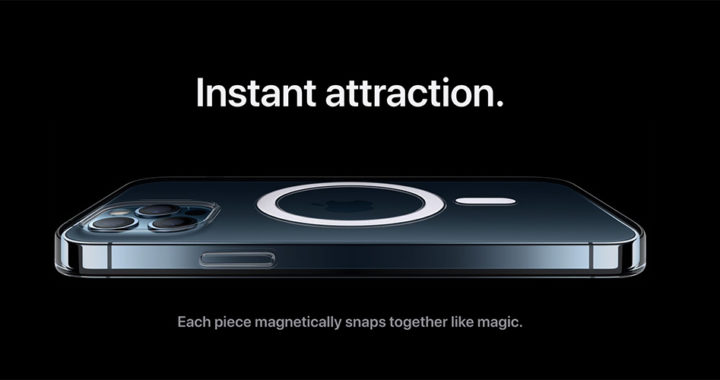Apple reintroduced the MagSafe Charger in October 2020 alongside the announcement of the iPhone 12 series of smartphones. Note that the company first used the term “MagSafe” to refer to the proprietary magnetic charging cables and ports found in earlier versions of MacBook computers before replacing them with USB-C charging.
The repurposed terminology now represents the magnet-based charging accessories and the specific wireless power transfer based on inductive charging technology designed for the new generation of iPhones. The entire system consists of a magnetic ring and a wireless charging coil placed inside the backside of the iPhone, as well as specific charging accessories such as cables that connect to a charging brick, standalone power banks, and wireless surface chargers.
The charging accessories magnetically attach to the magnetic back of the iPhone. Apple noted that the “MagSafe” concept represents not only wireless charging peripherals but also an entire ecosystem of accessories such as phone cases and other attachments that bank on the magnets placed on the back of the iPhone.
Pros: Advantages of MagSafe Charging
Of course, for the sake of the aforesaid topic, this article limits the topic to the new wireless charging technology found in new generations of iPhones.
The following are the advantages:
• Easily Attachable: Placing magnets inside the backside of the iPhone and on the charging interface itself solves the problem of other wireless charging-enabled smartphones that do not readily connect to wireless charging pads. A MagSafe charger easily clips on the back of an iPhone.
• Faster Wireless Charging: Earlier implementations of wireless charging suffer from slow charging speeds. The technology from Apple still uses the Qi charging standard. However, new generations of iPhones support wireless charging at 15W. Hence, it is one of the fastest technologies in the market.
• Less Wear and Tear: One of the advantages of wireless charging is that it reduces the need to plug and unplug a device to a cable that could wear and tear not only the charging wires but also the charging ports on the devices. Note that Apple chargers and cables are notorious for breaking easily. A wireless charger that magnetically and easily attaches to a phone reduces further wear and tear.
• Optional Accessories: The addition of a magnetic area inside the backside of iPhones opens new possibilities for additional accessories. These include power banks that support wireless charging, stands and mounts that magnetically attach to the back of an iPhone, and other accessories such as portable light and microphones, among others.
Cons: Disadvantages of MagSafe Charging
MagSafe is undeniably an interesting add-on feature of the iPhone. However, some of its drawbacks stem from the limitations of wireless charging technology.
Below are the disadvantages:
• Accessories are Expensive: The accessories are expensive. MagSafe Charger retails at USD 39.00, while the MagSafe Duo Charger retails at USD 129.00. Supported phone cases retail between USD 49.00 and USD 59.00, while the leather wallet and leather sleeves are priced at USD 59.00 and USD 129.000, respectively.
• USB-C Charging is Faster: Of course, one of the disadvantages of wireless charging is that it cannot compete against wired charging. In situations when time is of the essence, and the user needs to quickly charge-up his or her phone before going out, he or she is better off using a charging cable and a charging brick that supports fast charging.
• Not Entirely Wireless: A wireless charger still needs to be connected to a power source in most cases. A wireless power bank is an exemption. However, the fact remains that wireless power transfer still requires plugging in a power outlet. Freedom in movement while wireless charging is still limited.





